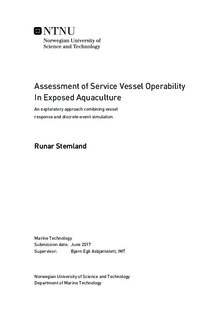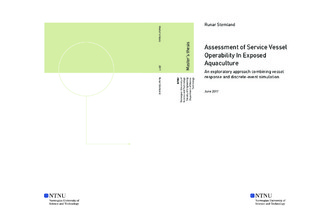| dc.description.abstract | The aquaculture industry in Norway is gradually moving towards more exposed locations due to lack of production area and improved production environment.
However, large parts of the coast are unavailable to production activity due to harsh environmental conditions. Through research, a better interaction between vessel and structure components, operability criteria and tools for decision-making have been identified as key issues to develop safe and reliable production in exposed aquaculture.
The objective of this thesis is to increase knowledge and insight of service vessel operations in exposed aquaculture, with a focus on vessel response and operability during the interaction with facility structures. Through a vessel response analysis and specification of operability criteria for the Macho 40 service vessel, quantitative limits of operation are determined. Along with measured wave data from oceanographic buoys, the operational limits are used as input in a simulation model to analyse the vessel's long-term operability.
The results from the vessel response analysis show that the wave heading is of major importance to the vessel's operating limits. In general, the vessel appears to be more sensitive to lateral wave headings with regard to maximum wave height, than for head and following sea. It is also found that roll is the most critical motion with respect to the vessel's operability. The long-term operability obtained from the simulation shows a tendency to follow the operational limits. It seems clear that the operability increase with the vessel's ability to avoid operating in lateral wave headings. Further, seasonal variations in operability show a reduced ability to perform operations in periods with increasing wave heights, and vice versa.
Efforts have been made to achieve realistic operational limits through specification of criteria modified for the design of the Macho 40. Together with wave data from two exposed aquaculture locations, this contributes to increase the quality and scientific value of the thesis towards the aquaculture industry. However, the validity and reliability from the simulation output are affected by uncertainty regarding frequency and duration of vessel operations and a limited amount of available wave data. The results should therefore not be considered exact values, but rather as indications on the vessel's sensitivity to incident wave headings, as well as estimations of its long-term operability. In accordance with the objective of the thesis, it can be concluded that increased knowledge and insight on service vessel operations in exposed aquaculture have been obtained and that, with further research and longer wave data series, the combination of hydrodynamic analysis and simulation could prove to be a useful approach in assessing and comparing the long-term performance of different vessel designs. | |

